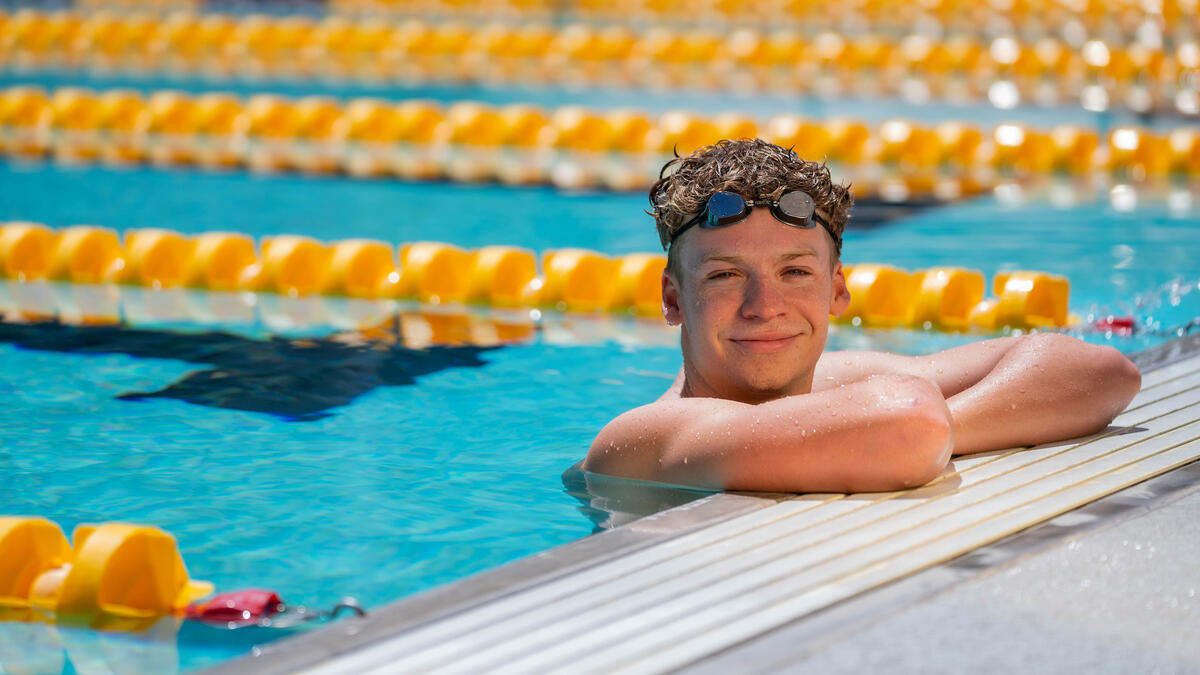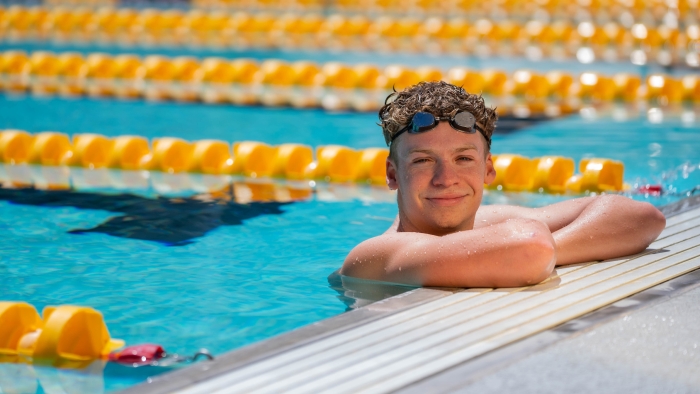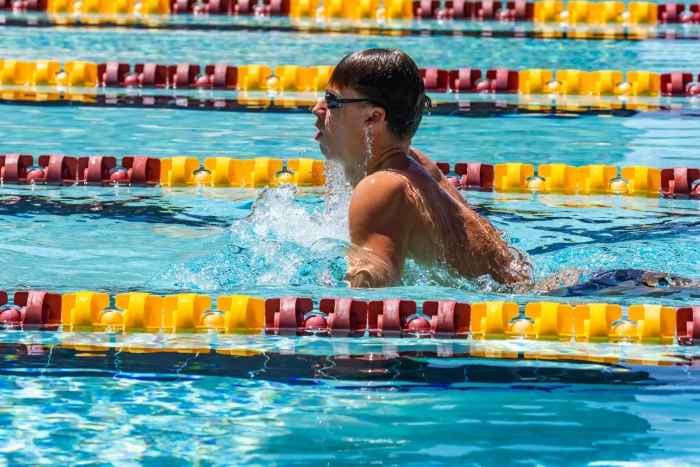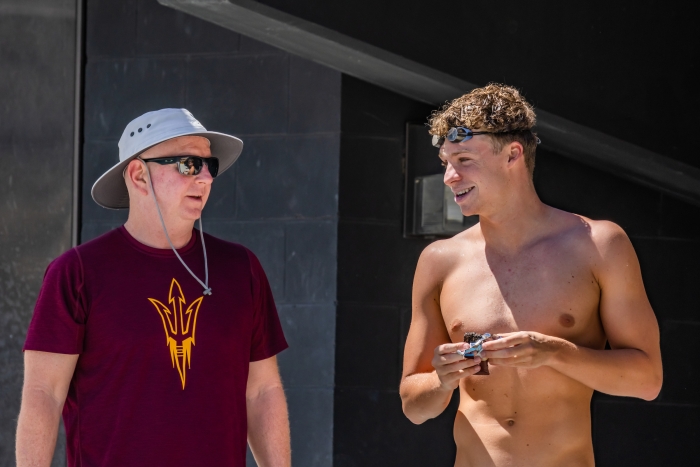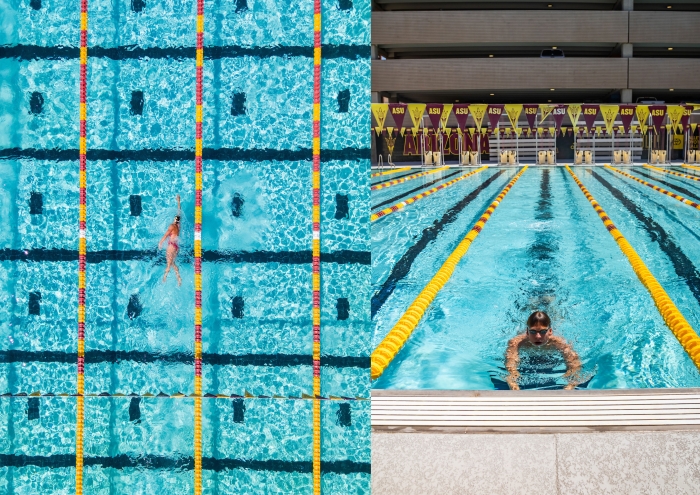Editor’s note: This story is featured in the 2023 year in review.
Léon Marchand was 7 years old when he quit swimming.
He didn’t quit because his parents, Xavier Marchand and Céline Bonnett, were pushing him to take up a family business. (Xavier Marchand had competed in the 1996 and 2000 Summer Olympics for France, and Bonnet took part in the 1992 Games.)
And he didn’t quit because he was afraid of the work.
He quit because, well, the water was too cold.
“I was like, really skinny and the pool was just awful,” Marchand said. “So, I quit swimming for two years.”
It’s funny to think about, now, that the Arizona State University 21-year-old sophomore who won six medals (including three gold) at the 2023 NCAA Division I men’s swimming championships … and became arguably the sport’s best male swimmer … and may break the 15-year-old 400 individual medley record set by Michael Phelps … gave up the sport because he was cold.
But a legend has to start somewhere. Why not a shivering kid with a towel wrapped around his waist?
Fast-forward 14 years. Marchand is talking to a reporter as he stands on the deck at ASU’s Mona Plummer Aquatic Complex. He’s trying to explain the single-minded focus it takes to be a world-class swimmer.
“It’s a very difficult sport,” he says. “It’s kind of hard to enjoy the process all the time. You’re training for years for a race that might last 20 seconds.”
That sacrifice is why Marchand’s parents were unbothered when he left the pool to take up other sports, including rugby. They encouraged him, in fact, to explore other outlets. But he was never as good on the land as he was in the water so, at the age of 9, he embraced his fate.
ASU is thankful he did.
ASU swimmer Léon Marchand poses for a photo at Mona Plummer Aquatic Center on the Tempe campus on April 28. Marchand, who is an international student from Toulouse, France, is expected to compete in the 2024 Summer Olympics. Photo by Samantha Chow/ASU
Staying grounded
Here’s the first thing you’ll notice about Léon Marchand: He’s not noticeable.
Where Michael Phelps was seemingly constructed to swim laps around everyone with his 6-foot-4 frame and 79-inch wingspan, Marchand looks, well, average.
He's 6-foot-2, 170 pounds, and when he strolls down Palm Walk only the most devoted swimming fans recognize him.
“If you compare him to some of the other top swimmers in the world right now, they’re all giant pieces of muscle,” ASU teammate Daniel Matheson said. “Léon doesn’t really follow that. His body type doesn’t scream an elite all-star athlete.”
Marchand doesn’t mind the jab. In fact, he embraces the perception, hoping he can be an inspiration for others.
“I’m trying to show how you can work with your own body,” he said. “You don’t have to be very big or very tall to swim fast or do your own thing. I just want to show that when you’re different you can (succeed).”
Marchand is doing just that. When the 2023 World Aquatics Championships are held in Fukuoka, Japan, on July 14–30, he will be one of the favorites to win gold in the 200 butterfly, the 200 individual medley and the 400 individual medley.
And when the 2024 Summer Olympics are held in Paris, Marchand could become the face of the Games.
“I’m like, ‘Dude, you’re going to be the most famous person there,’” Matheson said.
So, how does an average-size young man without a shred of arrogance — he acts just like a regular kid, according to ASU coach Bob Bowman — become one of the world’s best swimmers?
That story starts with a flight out of France and continues with lap after lap after lap.
ASU swimmer Léon Marchand practices at the Mona Plummer Aquatic Center on the Tempe campus on April 28. Photo by Chris Goulet/ASU
A fish out of water
By the time he was 18, it was obvious Marchand had world-class ability. He had already competed in the 2020 Olympics, with a best finish of sixth in the 400-meter individual medley.
“I was doing well,” Marchand said.
But his parents understood that to evolve as both a swimmer and a young man, Marchand needed to leave Toulouse, a city of about 500,000 in the southern region of France, travel overseas and be on his own. They pushed him to go abroad, and Marchand chose ASU for an obvious reason: Bowman had coached Phelps.
“I knew I could trust him every day,” Marchand said.
The first few weeks in Tempe were rough on Marchand. He not only had to learn a new language, but he had to learn how to take care of himself. In France, at home, his laundry was done for him; his meals were cooked for him. In Tempe, he learned quickly that clothes will shrink if they’re washed at the wrong temperature.
“In class, I had to listen a lot just to understand,” said Marchand, who is majoring in computer science. “Every day I was going to bed at like 5 p.m. because I was dead. But it got better. Now, I can do everything myself, which is a great thing.”
Video by Ken Fagan/ASU News
Following in Phelps’ footsteps
Back at the pool, it’s easy, but perhaps unfair, to compare Marchand to Phelps.
They’re not the same swimmer or the same person.
But Bowman says they are similar in one very important way: Their dedication to their craft is absolute, including the discipline needed to conquer the monotony of swimming practice.
“They’re very different personality-wise, but the way they approach the actual racing and the training is very similar,” he said. “They’re very consistent on a day-to-day basis, and at a consistently high level in training every day.
“You’re going to spend somewhere between two to four hours a day in the pool, basically just going up this black line and coming back down,” Bowman explained. “It’s boring. And there’s really no way of getting away from that kind of boringness. … You have to want it pretty bad. I think it takes somebody who very much has an appreciation for delayed gratification.”
Léon Marchand says he chose to swim at ASU so he could train under Bob Bowman (left), who had coached Michael Phelps. Photo by Chris Goulet/ASU
Matheson, who lives with Marchand, said he’s constantly amazed at his roommate’s ability to turn it on during practice.
“He destroys everyone every day,” Matheson said. “It’s just crazy to try to explain it to someone because it’s honestly unreal. I’ve never seen anyone train the way he does. He makes other people look silly. He’s just on a different level than anyone else.”
Bowman said there were times he would watch Phelps in practice and think he was watching something no one had ever done before. He gets the same feeling occasionally with Marchand.
Bowman recalled a practice where the Sun Devils were doing a set of 500-yard freestyles, which Marchand had never swum in a meet. One set remained, and Bowman challenged Marchand to see how fast he could swim. Marchand asked what Phelps’ best time was.
Four minutes and 23 seconds, Bowman said.
“So Léon (does) 4:18, and I know nobody’s doing that,” Bowman said. “And then he swam it at a meet two weeks later, and it was like the fifth-fastest one ever. So, he’s pretty good at mentally comparing himself to Michael.”
Marchand said he and Phelps have yet to meet in person. They sometimes text, but it’s Bowman who has Marchand’s ear and sees his talent.
“When he came to me, he had already qualified for the Olympics. So, he was on a high level,” Bowman said. “But he has exponentially improved the last two years to where he’s arguably the best swimmer in the world right now.”
ASU swim coach Bob Bowman says that Léon Marchand is "arguably the best swimmer in the world right now." Photos by Samantha Chow and Chris Goulet/ASU
Still room for improvement
The best swimmer in the world is considering his future: The World Aquatics Championships this month, the 2024 Summer Olympics in France.
But before Marchand goes home, there’s one other goal.
ASU finished second in the NCAA Men’s Swimming and Diving championships in March of this year, behind California.
Marchand wants more, which is one reason he plans to return to ASU to swim competitively for the Sun Devils in 2023–24.
“I know we can do better,” he said. “I know we can win. And I want to be a part of it.”
RELATED: See how the Sun Devils did in the 2022–23 Pac-12 Year In Review
More Sun Devil community

3 outstanding ASU alumni named The College Leaders of 2024
Three outstanding Arizona State University alumni from The College of Liberal Arts and Sciences will be named as this year’s slate of The College Leaders. The honor recognizes alumni for their…

From mushy ice to Mullett Arena
Greg Powers rubbed the top of his head and smiled.Powers, Arizona State University’s hockey coach, had been asked to reflect on the 10th anniversary of ASU hockey becoming an NCAA Division I program…

Open Doors report: ASU’s doors are open to the world
For the fourth straight year, Arizona State University is being recognized as the top public university choice of international students by the Institute of International Education in its annual…
